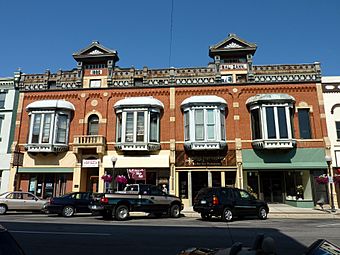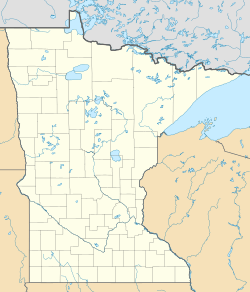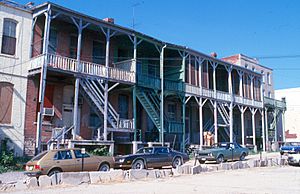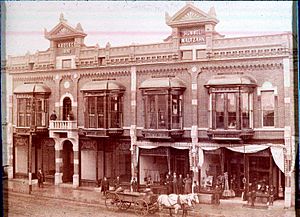Boesch, Hummel, and Maltzahn Block facts for kids
Quick facts for kids |
|
|
Boesch, Hummel, and Maltzahn Block
|
|
 |
|
| Location | 6-12 N. Minnesota St., New Ulm, Minnesota |
|---|---|
| Area | less than one acre |
| Built | 1890 |
| Architect | Carl F. Struck |
| MPS | Brown County MRA |
| NRHP reference No. | 79001201 |
| Added to NRHP | December 31, 1979 |
The Boesch, Hummel, and Maltzahn Block is a historic building in New Ulm, Minnesota. People also call it the Boesch-Hummel-Maltzahn Block. This private building was added to the National Register of Historic Places (NRHP) on December 31, 1979. It is special because its front looks much more detailed than other buildings on "Main Street" in New Ulm and nearby areas.
Contents
What Does the Building Look Like?
The Boesch, Hummel, and Maltzahn Block has two stories. It is on the north side of New Ulm's main shopping street. The building includes addresses 6, 8, 10, and 12 Minnesota Street North.
The front of the ground floor has been updated many times. However, it still has its original stone dividers. The second floor has bricks laid in a special way. It also features four large bay windows with copper roofs. You can see decorative cut stone on the second level too. There is also a balcony with a railing over the stairway entrance on the north side.
Fancy metal decorations at the top of the building show the names of the first owners. They also show the year the building was finished. The back of the building used to have wooden stairs and covered walkways. Now, it has metal stairs for people to get inside.
Who Built This Important Building?
William Hummel was born in 1832 in a place called Württemberg, which was part of Germany. He moved to the United States with his parents in 1844. Their ship journey was very long and difficult.
They arrived in New Orleans in 1845. Soon after, his family moved to Cincinnati. There, they worked at his uncle's vineyard. After a year, William's father died. This made things very hard for his family.
William, as the oldest, started working at a drug store. He earned a small amount of money and got a place to live. Later, he learned how to make harnesses. He then became a trunk-maker, which helped him earn a steady living.
In 1850, he joined the Cincinnati Turner Society. This group helped him connect with German customs and language. The Turner Society was important to William because it supported free thinking. He then worked on steamers on the Ohio River and Mississippi River. This job paid more and let him see more of the country.
William Hummel in New Ulm
William Hummel moved to New Ulm in 1856, soon after the town was founded. He helped start New Ulm's own Turner Society. He also taught gymnastics in the new hall.
He tried different jobs, like farming and running a drug store. In 1880, he helped start the New Ulm Creamery Company. This business was very successful. With his earnings, he opened a general store on Minnesota Street.
By 1890, William Hummel was one of the most successful businessmen in New Ulm. He teamed up with Werner Boesch and Edward Maltzahn to build a new business block. They hired Carl F. Struck, an architect from Minneapolis. Struck had also designed the Brown County Courthouse.
The Boesch, Hummel, and Maltzahn Block was built in 1890. It was one of the newer, strong buildings made of brick and stone. These buildings were made to hold shops in New Ulm. Many people think it was the most impressive building of its time. William Hummel continued to run his store there until 1903.
Why This Building is Important
The Boesch, Hummel, and Maltzahn Block is known for being the most detailed commercial building on Main Street in the area. Often, older buildings lose their special features over time. Things like decorative tops and sticking-out windows are often removed during updates.
However, this building has kept its unique look. Its wide front has four storefronts, which makes it stand out. This design adds a lot to the look of the street. The building was first made to have shops on the first floor. Apartments were on the second floor. It was still used this way when it was added to the National Register of Historic Places.





